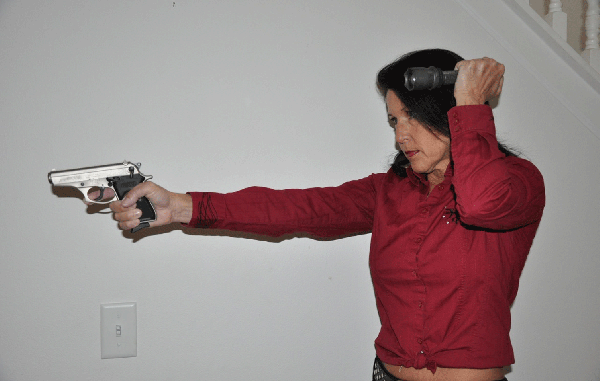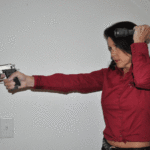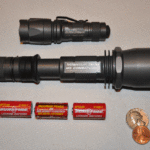
You need a good light
Nothing is more terrifying to a homeowner than a “hot” burglary. That’s what detectives call incidents where cold-blooded cretins, crawling out of their skins with drug addictions, creep a house with the occupants home, generally asleep. Worse yet are those who get a sexual thrill from the power trip of invading a home and creeping it while the occupants are sleeping. The ultimate thrill for this scum is to enter the bedroom and watch the occupants sleep.
A “hot” burglary is a frightening, sobering thing. You awaken to the realization that someone — a stranger — is in your home, and while you heard the noise, you might not know where he is located in the house. Never mind how he got in, the fact is you know a stranger is in your home, and you need to have a plan in place to combat this invasion.
There may come a time when you have to conduct a search of your own house to make sure it is occupied only by you and your loved ones.
If you hear or suspect a break-in, most experts recommend barricading yourself in your bedroom and calling the police.
But this common advice does not take into account whether you might have children elsewhere in the house.
Having others in the house makes it essential that you have a plan in place, and know how to search the house as safely and efficiently as possible.
I have gone into many houses that had been burglarized — the homeowners discovered a forced entry upon returning home. They called law enforcement, and we had the experience of entering and searching the house to make sure the undesirables had left. This is one of street cops’ least favorite things to do.
In all these cases, and in practically every one I am aware of, how many times do the police use shotguns?
Not many.
I never used one for that, either.
And I will tell you cops LOVE their shotguns. If they have to be faced off against anything, they would readily choose the riot guns in their units over their handguns.
But a shotgun, no matter how much it is touted as the ultimate home-defense weapon, is too unwieldy for the close quarters of a house search. The shot pattern of a standard modified choke is 4 to 6 inches at 20 feet, a reasonable approximate size for most rooms in a home. Thus, you can easily miss with a shotgun at room ranges.
And when you start slipping around corners and entering rooms, that shotgun is the first thing coming through, announcing your position prematurely, and it is big enough to be grabbed and taken away from you in a struggle.
So if you have to do a security search of your house, a handgun is a more viable option — that’s what the cops use, and with good reason.
But they use one other item that is indispensable in every cop’s equipment list — a good flashlight. And I’m not talking about a D-cell you bought at the hardware store, or a “rechargeable” one that plugs into a cradle on the wall and cost $20.
Cops spend money on flashlights that work every time they turn them on — there are many “tactical” styles of flashlights on the market that will suffer the worst abuse you can dish out, and keep shining like the midday sun every time you use them.
They will generally have aluminum tubes, and heavy-duty cradle chargers that will keep them charged and ready to go forever. Many of these carry great warranties that mean you basically buy one flashlight and carry it forever.
Two popular names in the law enforcement/military market are Surefire (http://www.surefire.com/) and Streamlight (http://www.streamlight.com/).
I have owned several different styles from both of these manufacturers, and have found them to be practically unbreakable and indispensable.
You ask a civilian if he would pay $100 for a flashlight, and he will look at you as if you have a third eye. Ask a cop, and he will wonder why you keep going back to the hardware store every year replacing junk flashlights.
Professional tactical flashlights are markedly brighter, their run times are much longer, and their battery life is greatly extended. While they may cost more, they work better, more efficiently, and last for decades.
There are specific techniques for using a flashlight with a handgun — if you don’t have a handgun with a built-in rail that allows the attachment of a light.
One method is using a quality tactical light. Hold the light in your offhand slightly to the side and above your ear while pointing the handgun with your strong (shooting) hand. This serves several purposes — it gets the light away from your body if the bad guy tries to use it as a target, it allows you to illuminate objects or persons without pointing the gun at them, and equally important, it holds the light in a cocked striking position, allowing you to bring the full force of your arm down, striking the assailant with the pointed extrusions on the lens end. Yes, that is exactly what those pointy things are for — hit him with those, it’s going to grab hide and flesh, and it is going to HURT!
Another technique, developed by SureFire, holds a smaller flashlight with the fingers of the secondary (non-shooting) hand against the gun. Much like a rail light attached to the gun, the light and the gun point at the same thing all the time.
The last thing we will discuss is what I was taught in law enforcement, and it is probably the most popular. In this technique, the wrist of the shooting hand rides over the wrist of the off-hand, giving strong support to the shooting hand. The off hand holds the flashlight with the lens end extending from the bottom of the palm. The light-holding wrist steadies the gun wrist; the gun wrist steadies the light wrist.
Whichever method you decide works best for you, buy a quality tactical flashlight and practice with it and your handgun — it could save lives.




